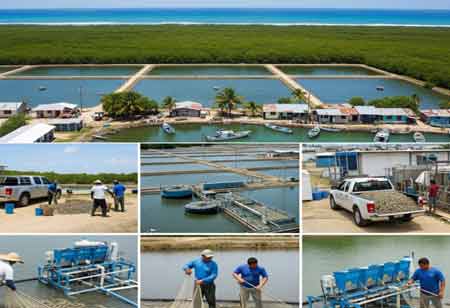Thank you for Subscribing to Food Business Review Weekly Brief
- Home
- Topics
- Alternative Proteins and Plant Based Food
- Beer and Wine
- Canned Beverages
- Coffee And Tea
- Food and Beverage Consulting
- Food and Beverage Financial Service
- Food And Beverages Marketing
- Food Distributors
- Food Ingredients
- Food Sustainability
- Plant Based Food and Beverages
- Seafood Suppliers
- Supplement Manufacturing
- Wine Investment
- News
- Vendor Viewpoint
- CXO Insights
- Conferences
- Newsletter
- CXO Awards
-
Latin America's Shrimp Industry Expands Its Global Footprint
The Latin American shrimp industry is a vital economic driver, emphasizing diverse production methods, technological advancements, and sustainability to meet growing global seafood demand.

By
Food Business Review | Tuesday, July 15, 2025
Stay ahead of the industry with exclusive feature stories on the top companies, expert insights and the latest news delivered straight to your inbox. Subscribe today.

The Latin American shrimp industry stands as a significant contributor to both regional economies and the global seafood market. Characterized by a rich diversity of production systems and a continuous drive towards advancement, the sector has cemented its position as a major supplier of farmed shrimp, predominantly the Pacific white shrimp (Litopenaeus vannamei). This species accounts for a vast majority of the region's farmed production due to its adaptability and growth characteristics.
The industry's origins in Latin America trace back several decades, with significant expansion occurring in the latter half of the 20th century. Countries across the region, particularly those with extensive coastal areas and suitable climatic conditions, have witnessed substantial growth in shrimp aquaculture. This expansion has been a result of a combination of favorable natural endowments, strategic investments, and evolving market demands. The geographic proximity to major import markets, notably in North America and Europe, has also played a crucial role in shaping the industry's export-oriented focus.
Production Systems and Technological Progress
Production systems in Latin America exhibit a range of approaches, from semi-intensive operations, which are common in many areas, to more intensive models. These systems often involve the fertilization of aquatic environments and the use of formulated diets to enhance shrimp growth. The operational scale varies considerably, encompassing a blend of smaller-scale and larger, vertically integrated farms. This diversity in farming practices allows for adaptation to different local conditions and resource availability.
Technological advancements have been a consistent theme in the evolution of the Latin American shrimp industry. Innovations in hatchery practices have led to the greater availability of disease-free post-larvae, a critical factor for consistent production. Developments in feed formulations, including nutritionally balanced diets, have improved feed conversion rates and overall growth efficiency. Furthermore, the increasing adoption of automated feeding systems and sophisticated water filtration technologies is enhancing productivity and optimizing resource utilization. The integration of data analytics, including artificial intelligence and computer vision systems, is beginning to emerge, offering advanced tools for real-time monitoring of shrimp growth, health, and environmental parameters, ultimately aiming for more precise and efficient farm management.
Economic Impact and Market Dynamics
The economic impact of shrimp production in Latin America is substantial, generating significant revenue and contributing to foreign exchange earnings for several nations. The industry is a source of employment in coastal communities, supporting a wide array of associated businesses, from feed manufacturers to processing plants and logistics providers. The export orientation means that the sector plays a vital role in trade balances, with a substantial portion of the region's farmed shrimp destined for international markets. While the global shrimp market can be subject to price fluctuations, the Latin American producers have demonstrated resilience and a commitment to maintaining their competitive edge.
Market trends for Latin American shrimp are heavily influenced by global demand. While traditional markets in the United States and Europe remain significant, there is a growing focus on expanding export destinations, including emerging markets in Asia and the Middle East. The emphasis on product quality, safety standards, and traceability is paramount for accessing these diverse international markets. The industry is also seeing a shift in consumer preferences, with an increasing appreciation for responsibly sourced seafood, which encourages producers to adhere to recognized best practices.
Sustainability and Future Outlook
From an environmental perspective, the Latin American shrimp industry is increasingly focusing on approaches that minimize its ecological footprint. This involves careful site selection to avoid ecologically sensitive areas like pristine mangrove forests, and the implementation of improved pond design and water management strategies. Efforts are being made to reduce water exchange, improve water residence time, and explore bio-filtration methods to manage effluents. The use of robust biosecurity protocols and the exploration of ecological approaches, such as polyculture, are also part of the broader commitment to more sustainable production. The industry recognizes the importance of maintaining the health of coastal ecosystems to ensure long-term viability.
The regulatory landscape surrounding shrimp production in Latin America is continuously evolving. Governments and industry stakeholders are working to develop frameworks that promote responsible aquaculture practices. These regulations often address aspects such as environmental protection, biosecurity, and labor standards. While the specific details may vary by country, there is a general trend towards strengthening oversight and encouraging self-regulation within the industry, driven by a shared understanding of the need for sustainable growth.
The Latin American shrimp industry is poised for continued development. While growth rates may moderate in some established producing areas after periods of rapid expansion, other regions within Latin America are experiencing accelerated growth. The sustained global demand for seafood, coupled with ongoing advancements in farming technologies and management practices, provides a positive outlook for the sector. The industry's capacity to adapt to market shifts, embrace innovation, and prioritize responsible production will be key to its enduring success and its ongoing contribution to global food security.






